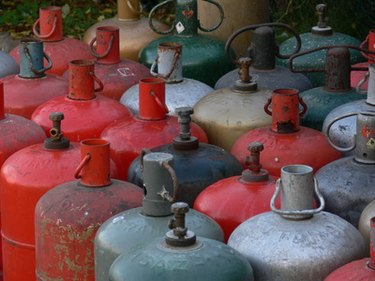Things You'll Need
Leak testing fluid
Clean rag
Replacement O-ring (optional)

The propane tank regulator is fitted to the top of a portable tank or the outflow port of a permanent tank. Its purpose is to even out the flow of gas from the tank and ensure a smooth delivery at an even, predetermined pressure. It also serves as a non-return valve, so that if an uncontrolled flame should exist anywhere in the system it cannot flash back down the pipe and into the tank and cause an explosion. Serving both these vital needs, the regulator is an indispensable component in the propane system. Because propane is a potentially hazardous gas, resolving any problems with its delivery system is an urgent project, and a number of external checks can be carried out by the owner.
Step 1
Switch the propane system on by opening the regulator valve. Typically a regulator will have a half-turn knob or a 360-degree-turn knurled circular handle; rotate the valve clockwise to its fullest extent.
Step 2
Check for leaks around the regulator, its connection to the tank and the hose which transfers gas to the system. Use a proprietary liquid formulated for the testing of pressurized systems. Paint the solution around the regulator; if a bubble appears there is a leak to be fixed, and if no bubbles appear that part of the system is sound.
Step 3
Switch the system off by turning the valve anticlockwise to its fullest extent. Unscrew the regulator from the tank and visually inspect its underside for the presence of debris or liquid contamination. If any is present wipe it away with a clean, dry cloth. If the regulator is of the type which incorporates a rubber O-ring seal, ensure the seal is firm, resistant to deformation and has no powdery coating. If the seal is decayed, install a replacement.
Step 4
Reconnect the regulator and switch the valve on. If the initial problem remains, take the regulator to your licensed propane professional and have him disassemble the body to check the operation of internal components. He will also have specialist tools to test the output pressure of the regulated gas.
Tip
Never use a dilution of dishwashing detergent or hand soap to test for leaks. The solvents in the soap can cause a deterioration of thread-sealing tape or compound, and eventually create leaks at the very joints it is being used to test.
Warning
Propane is explosive, flammable and an asphyxiant. Treat it with great caution, and never have a source of ignition in the vicinity of the tank or regulator.